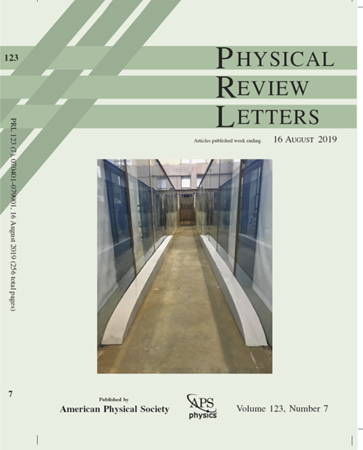Realization of Hilbert Space Fragmentation and Fracton Dynamics in Two Dimensions
IF 8.1
1区 物理与天体物理
Q1 PHYSICS, MULTIDISCIPLINARY
引用次数: 0
Abstract
We propose the strongly tilted Bose-Hubbard model as a natural platform to explore Hilbert-space fragmentation (HSF) and fracton dynamics in two dimensions in a setup and regime readily accessible in optical lattice experiments. Using a perturbative ansatz, we find HSF when the model is tuned to the resonant limit of on-site interaction and tilted potential. First, we investigate the quench dynamics of this system and observe numerically that the relaxation dynamics strongly depends on the chosen initial state—one of the key signatures of HSF. Second, we identify fractonic excitations with restricted mobility leading to anomalous transport properties. Specifically, we find excitations that show one-dimensional diffusion (在二维空间实现希尔伯特空间分裂和分形动力学
我们提出了强倾斜玻色-哈伯德模型,将其作为一个天然的平台,在光晶格实验中以容易获得的设置和机制探索二维中的希尔伯特空间碎片(HSF)和分形子动力学。利用微扰解析,当模型调整到现场相互作用和倾斜势的共振极限时,我们发现了 HSF。首先,我们研究了该系统的淬火动力学,并从数值上观察到弛豫动力学强烈依赖于所选的初始状态--这是 HSF 的关键特征之一。其次,我们发现了具有受限流动性的分形激元,这导致了反常的传输特性。具体来说,我们发现了显示一维扩散(𝑧=1/2)的激波,以及显示二维亚扩散行为(𝑧=3/4)的激波。我们使用细胞自动机分析了它们的动力学,并将其与有效的流体动力学描述进行了比较。
本文章由计算机程序翻译,如有差异,请以英文原文为准。
求助全文
约1分钟内获得全文
求助全文
来源期刊

Physical review letters
物理-物理:综合
CiteScore
16.50
自引率
7.00%
发文量
2673
审稿时长
2.2 months
期刊介绍:
Physical review letters(PRL)covers the full range of applied, fundamental, and interdisciplinary physics research topics:
General physics, including statistical and quantum mechanics and quantum information
Gravitation, astrophysics, and cosmology
Elementary particles and fields
Nuclear physics
Atomic, molecular, and optical physics
Nonlinear dynamics, fluid dynamics, and classical optics
Plasma and beam physics
Condensed matter and materials physics
Polymers, soft matter, biological, climate and interdisciplinary physics, including networks
 求助内容:
求助内容: 应助结果提醒方式:
应助结果提醒方式:


